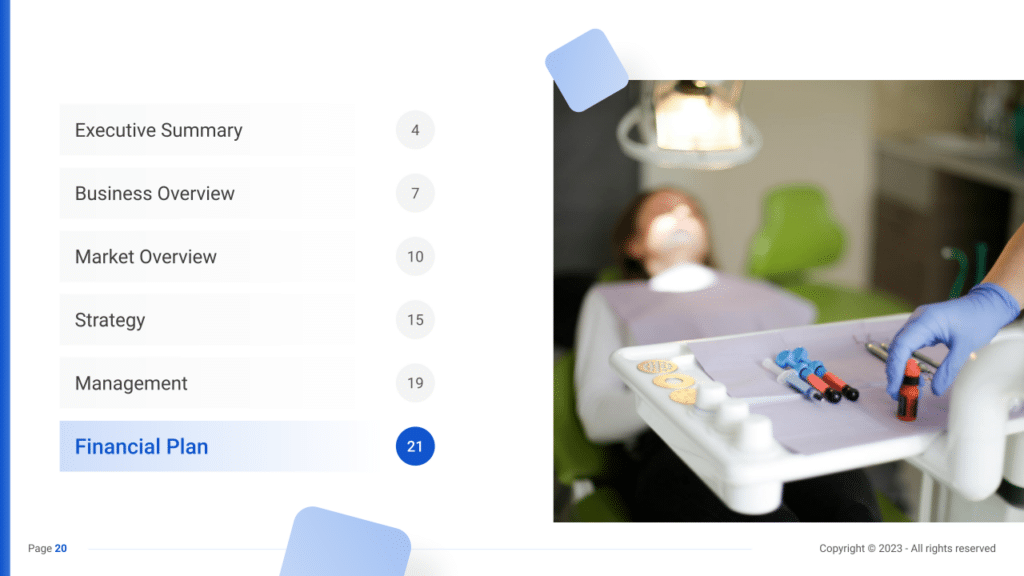Dental Practice Business Plan Template & PDF Example

Creating a comprehensive business plan is crucial for launching and running a successful dental practice. This plan serves as your roadmap, detailing your vision, operational strategies, and financial plan. It helps establish your dental practice’s identity, navigate the competitive market, and secure funding for growth.
This article not only breaks down the critical components of a dental practice business plan, but also provides an example of a business plan to help you craft your own.
Whether you’re an experienced entrepreneur or new to the healthcare industry, this guide, complete with a business plan example, lays the groundwork for turning your dental practice concept into reality. Let’s dive in!
The Plan
Our dental practice business plan is designed to be clear and comprehensive, covering all the essential aspects necessary for a detailed strategic outline. This plan elaborates on the practice’s operations, strategic direction, market positioning, competitive analysis, management structure, and financial projections, among other key components.
Here are the primary sections of our Dental Practice Business Plan:
- Executive Summary: A concise overview of your dental practice, showcasing the business concept, market positioning, leadership team, and a snapshot of financial plans.
- Business Overview: Delivers in-depth information on what your dental practice offers and its operational framework:
- Practice & Location: Details about the practice’s environment, equipment, and special features.
- Treatments: Information on the range of dental services provided, including general dentistry, cosmetic procedures, and pricing models.
- Market Overview: Analyzes the dental market, pinpointing key competitors and establishing your practice’s unique value proposition:
- Key Stats: Industry size, growth rates, and critical statistics relevant to the dental sector.
- Key Trends: Current trends influencing the dental industry, such as advances in dental technology or shifts in patient care standards.
- Key Competitors: Assessment of main competitors and how your practice stands out from them.
- Strategy: Outlines the growth strategy and client acquisition plans for the practice:
- SWOT: A detailed analysis of strengths, weaknesses, opportunities, and threats.
- Marketing Plan: Describes promotional tactics to attract new patients and retain existing ones, including digital marketing and community engagement.
- Timeline: Critical milestones and objectives from the opening phase to expansion, covering at least the first year.
- Management: Introduces the dental practice’s management team, emphasizing their roles, expertise, and how they drive the practice towards its goals.
- Financial Plan: Projects the practice’s financial performance over 5 years, detailing expected revenue, expenses, and outlines the funding strategy.

Executive Summary
The Executive Summary introduces your dental practice’s business plan, offering a concise overview of your clinic and its services. It should detail your market positioning, the range of dental care and treatments you provide, its location, size, and an outline of day-to-day operations.
This section should also explore how your dental practice will integrate into the local healthcare market, including the number of direct competitors within the area, identifying who they are, along with your practice’s unique selling points that differentiate it from these competitors.
Furthermore, you should include information about the management and co-founding team, detailing their roles and contributions to the practice’s success. Additionally, a summary of your financial projections, including revenue and profits over the next five years, should be presented here to provide a clear picture of your dental practice’s financial plan.
Dental Practice Business Plan Executive Summary Example
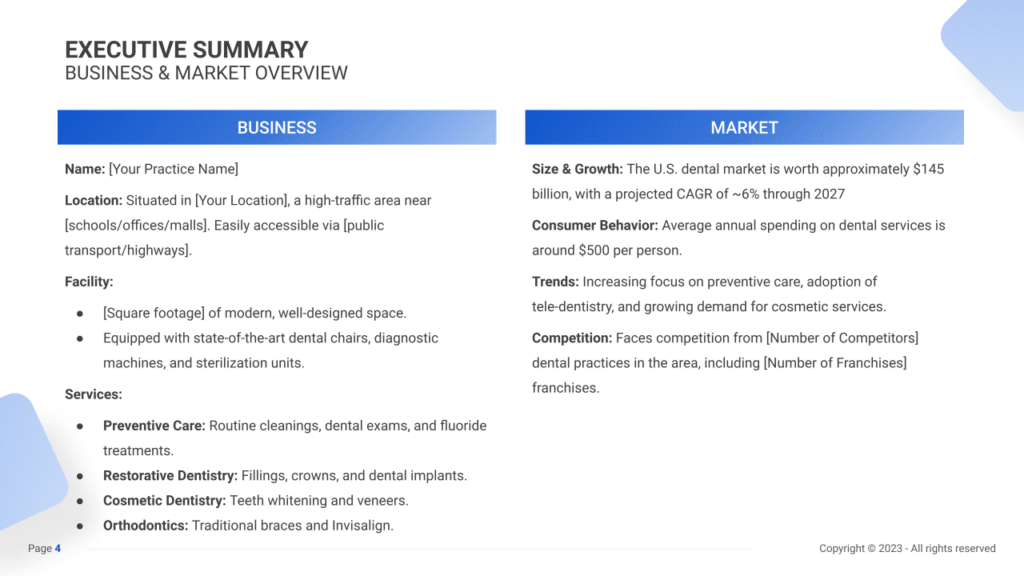
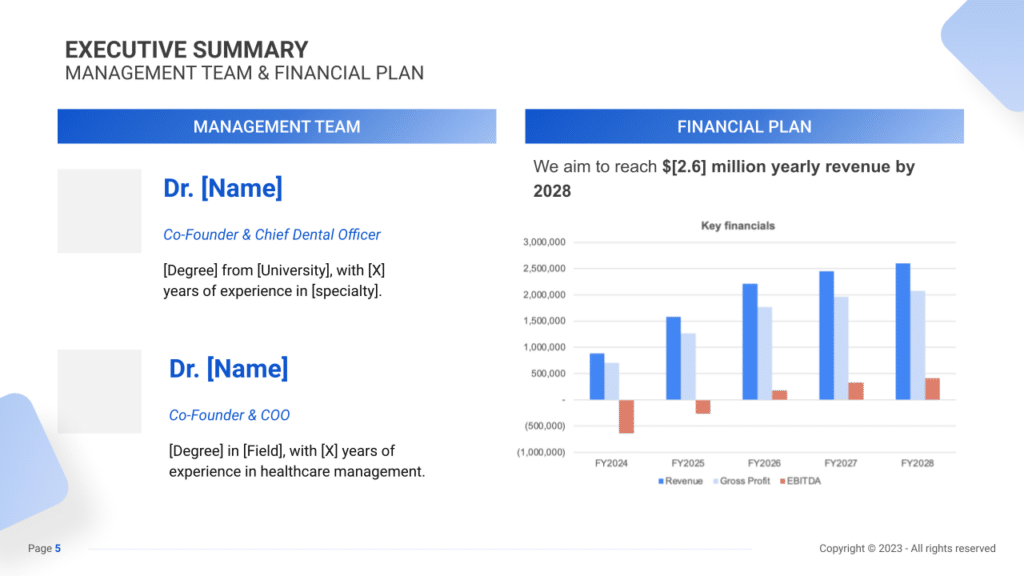
Business Overview
In the business overview, you should clearly define your dental practice’s characteristics, including the name, location, facility details, and range of dental services offered. Highlighting the unique aspects of your practice is crucial to set it apart in the dental market.
Example:
“SmileBright Dental,” located in Downtown Metropolis near schools and shopping areas, offers a modern, 4,000 sq. ft. facility with advanced dental equipment. The practice provides a comprehensive range of services, from preventive care and restorative dentistry to cosmetic procedures and orthodontics, catering to a diverse patient base.
Market Overview
This section should analyze the dental market size, growth trends, consumer behavior, and the competitive landscape. It helps position your practice within the industry and showcases how it meets the current demands in dental care.
Example:
SmileBright Dental enters a U.S. dental market worth $145 billion, growing at 6% annually. Despite competition from other local practices, SmileBright stands out with its focus on preventive care, adoption of tele-dentistry, and cosmetic services, aligning with current consumer trends and spending behaviors.
Management Team
Detailing the management team’s experience and roles is essential. This part of the summary should emphasize their expertise in dentistry and healthcare management, underscoring their ability to drive the practice’s success.
Example:
Dr. Jane Doe, Chief Dental Officer and co-founder of SmileBright, brings years of experience in pediatric dentistry, while Dr. John Smith, co-founder and COO, has extensive experience in healthcare management. Their combined expertise ensures high-quality patient care and efficient practice operations.
Financial Plan
A clear presentation of financial goals and projections is key. This section should include targets for revenue, providing insight into the practice’s financial health and growth prospects.
Example:
SmileBright Dental aims for $2.6 million in annual revenue by 2028. With a strategic focus on expanding service offerings and enhancing patient experience, the practice is poised for growth in a thriving dental market.
Business Overview
For a Dental Practice, the Business Overview section can be effectively divided into 2 main slides:
Practice & Location
Briefly describe the dental practice’s physical environment, focusing on its modern, clean, and inviting atmosphere that reassures and comforts patients. Mention the practice’s location, highlighting its accessibility and the convenience it offers to patients, such as proximity to residential areas, schools, or ease of parking. Explain why this location is strategically chosen to attract your target patient base.
Treatments
Detail the range of dental treatments and services offered, from routine check-ups and cleanings to specialized procedures like orthodontics, implants, or cosmetic dentistry. Outline your pricing strategy, ensuring it reflects the quality of care provided and aligns with the market you’re targeting. Highlight any special offers, insurance partnerships, or membership plans that provide added value to your patients, encouraging long-term relationships and patient loyalty.
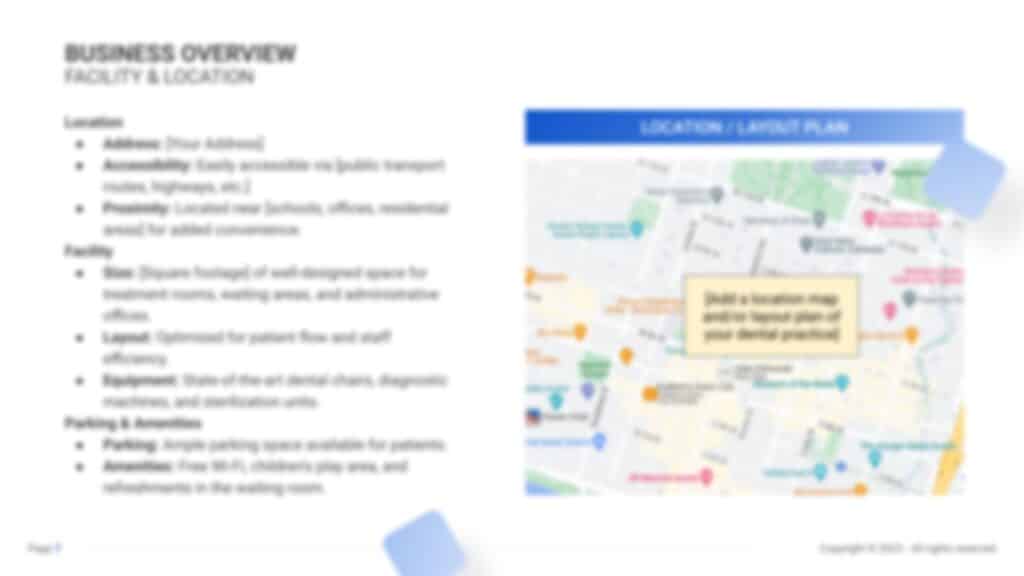
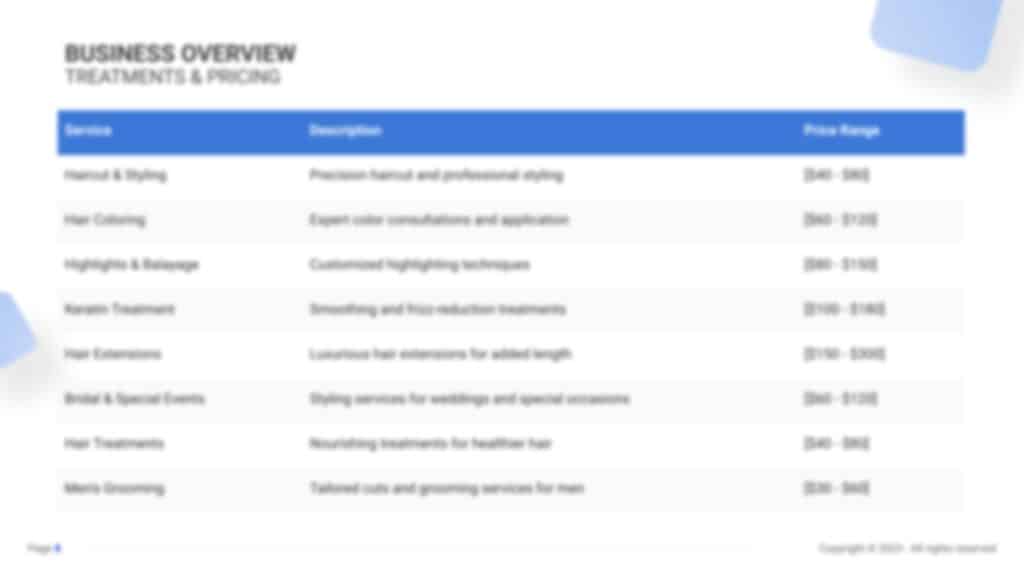
Market Overview

Industry size & growth
In the Market Overview of your dental practice business plan, start by examining the size of the dental care industry and its growth potential. This analysis is crucial for understanding the market’s scope and identifying expansion opportunities.
Key market trends
Proceed to discuss recent market trends, such as the increasing consumer interest in advanced dental technologies, preventive care, and cosmetic dental services.
For example, highlight the demand for services that cater to specific dental health needs, alongside the rising popularity of aesthetic dental treatments like veneers and teeth whitening. Also, consider the impact of digital dentistry advancements, such as 3D imaging and CAD/CAM systems, on patient experience and treatment outcomes.
Competitive Landscape
A competitive analysis is not just a tool for gauging the position of your dental practice in the market and its key competitors; it’s also a fundamental component of your business plan.
This analysis helps in identifying your dental practice’s unique selling points, essential for differentiating your business in a competitive market.
In addition, competitive analysis is integral in laying a solid foundation for your business plan. By examining various operational aspects of your competitors, you gain valuable information that ensures your business plan is robust, informed, and tailored to succeed in the current market environment.
Identifying Your Dental Care Competitors
Initiating a competitive analysis in the dental care sector begins with identifying key competitors in your locality. Map out dental practices within your vicinity, considering not only other dental clinics but also specialized services like orthodontics or cosmetic dentistry. Additionally, take into account corporate dental chains or multi-specialty clinics that may operate in your area, as they could pose competition.
Online platforms such as Google Maps, Yelp, or Healthgrades offer valuable insights. Reviews and ratings on these platforms provide a glimpse into the strengths and weaknesses of your competitors. For instance, positive reviews highlighting the efficient service and friendly staff at “SmileCare Dental” indicate a notable strength of your competitor in providing a positive patient experience.
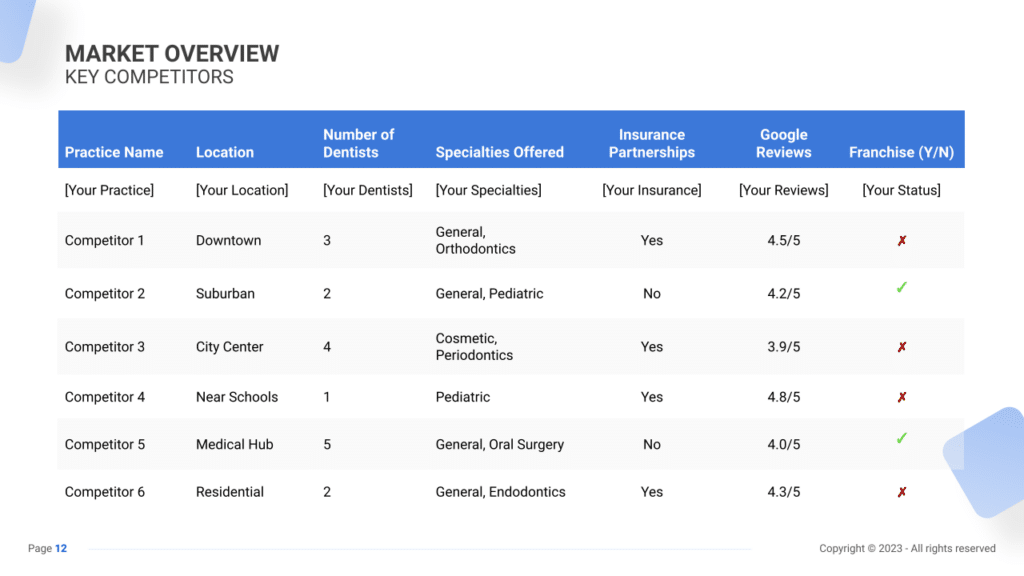
Dental Practice Competitors’ Strategies
Analyzing the strategies of your dental care competitors encompasses various facets:
- Services Offered: Evaluate the spectrum of services provided by competitors. If a nearby clinic like “Bright Smiles Orthodontics” is gaining popularity for its innovative orthodontic treatments, it signals a market trend toward specialized orthodontic care.
- Technology and Equipment: Consider the technological advancements and equipment utilized. A clinic that focuses on state-of-the-art equipment for procedures may attract a different clientele compared to a practice that emphasizes traditional techniques.
- Pricing Models: Compare pricing structures. Are your service fees similar to those at “Affordable Dental Solutions” or do you align more with premium services like those offered at “Elite Dental Care”?
- Marketing Strategies: Evaluate marketing approaches. Do competitors rely on digital marketing, social media campaigns, or community engagement events to promote their services?
- Patient Experience: Assess the patient experience at rival clinics. A clinic like “Comfort Dental Haven” might stand out for its calming ambiance and personalized patient care.
- Operational Efficiency: Observe if competitors leverage technology for appointment scheduling, digital records, or teleconsultation, such as “Tech-Savvy Smiles” with its advanced online appointment system.
What’s Your Dental Clinic’s Unique Value Proposition?
Identifying your dental clinic’s unique value proposition is pivotal. Perhaps your clinic specializes in pediatric dentistry or offers cutting-edge cosmetic dental procedures that are in demand.
Pay attention to market gaps by gathering patient feedback and staying updated on industry trends. For example, an increasing emphasis on holistic dental care could represent an untapped market opportunity if competitors still need to address this demand.
Tailor your services to your location. A clinic in a family-centric suburb might focus on family dental care and a child-friendly environment, while a practice in a corporate hub might highlight convenient scheduling and fast service for busy professionals.
Strategy
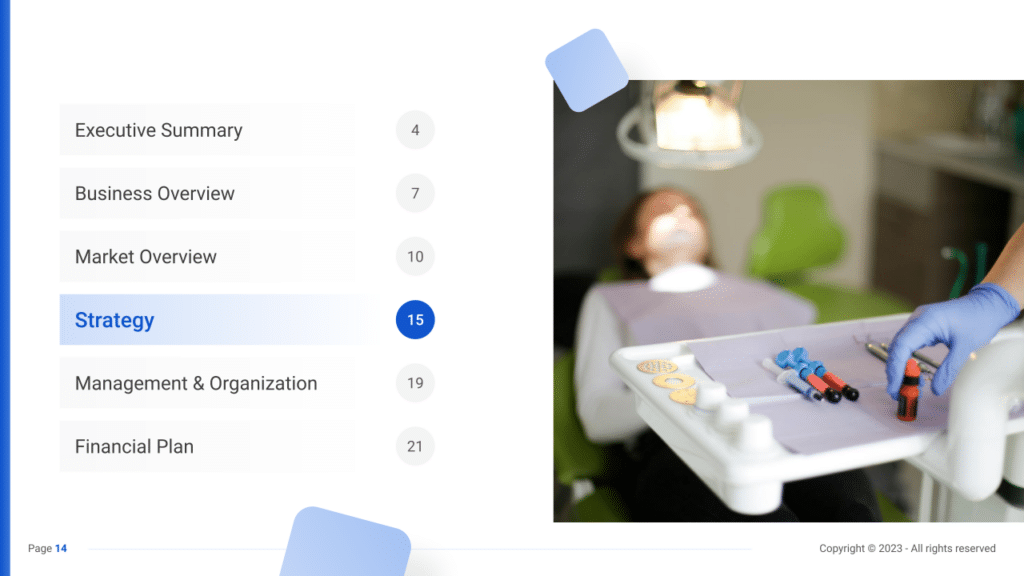
SWOT
First, conduct a SWOT analysis for the dental practice, highlighting Strengths such as highly qualified dental professionals and comprehensive dental care services, Weaknesses like high operational costs and the complexities of insurance billing, Opportunities in the form of increasing awareness about oral health and potential for community outreach programs, and Threats from intense competition and potential economic downturns that may affect patients’ spending on dental services.
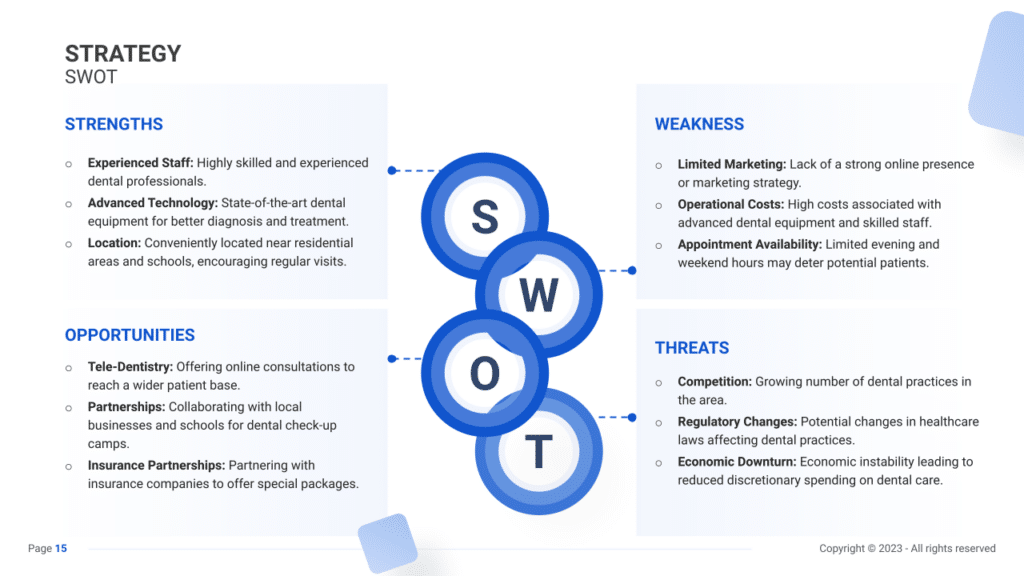
Marketing Plan
Next, develop a marketing strategy for the dental practice that details how to attract and retain patients. This strategy should include targeted advertising to reach potential patients actively searching for dental services, promotional discounts for first-time visitors or referrals, an engaging social media presence that highlights patient testimonials and educational content, and involvement in community events to build brand awareness and trust within the local area.
Marketing Channels
Utilize diverse marketing channels to engage with potential patients and increase brand visibility.
Digital Marketing
Leverage digital platforms effectively:
- Website and SEO: Your practice’s website serves as a digital storefront. Develop a user-friendly website that not only showcases your services but also educates visitors about oral health. Integrate patient testimonials and case studies to build credibility. Optimize the site for local SEO by including location-specific keywords, enabling potential patients to find you easily.
- Social Media: Social media platforms offer a space for interaction and community building. Regularly share valuable content—educational posts, engaging videos, patient success stories, and behind-the-scenes glimpses—to humanize your practice.
- Email Marketing: Building an email list allows you to nurture relationships with both existing and potential patients. Develop segmented email campaigns that offer value—whether it’s oral care tips, exclusive promotions, or updates about new services.
Local Promotion and Community Engagement
Actively participate in the local community:
- Local Events: Host or sponsor community health fairs, school dental check-ups, or seminars. Provide free dental check-ups or educational sessions at local community centers.
- Partnerships: Collaborate with local schools, health clinics, or businesses for joint health awareness campaigns or referral programs.
Promotional Activities
Entice potential patients with attractive offers:
- Special Promotions: Design promotional offers or seasonal packages that entice first-time visitors. Consider offering discounts on specific treatments or bundled services, encouraging new patients to experience the quality of care your practice provides.
- Loyalty Programs: Rewarding patient loyalty encourages repeat visits. Implement a structured loyalty program where patients earn points for each visit or referral, which they can redeem for discounts or complimentary services. This not only incentivizes loyalty but also enhances patient retention.
- Referral Bonuses: Encourage existing patients to become advocates for your practice by offering referral incentives. Provide discounts, free treatments, or other incentives for every successful referral they make, amplifying your reach through word-of-mouth.

Sales Channels
Deploy effective sales strategies to ensure a seamless patient experience and satisfaction.
In-Practice Upselling
Maximize opportunities during patient visits:
- Service Upgrades: During appointments, suggest additional treatments like teeth whitening or cosmetic dental procedures based on patient preferences and needs.
- Retail Products: Display dental care products or oral hygiene items prominently within the practice and educate patients about their benefits.
- Treatment Packages: Offer comprehensive dental care packages that bundle multiple treatments or family packages at discounted rates.
Online Booking and Sales
Leverage technology for efficient service delivery:
- Online Booking: Implement an easy-to-use online appointment booking system through your website or mobile app, offering convenience to patients.
- E-commerce: Sell dental products, oral care kits, or dental health supplements directly through your website, expanding patient access and revenue opportunities.
- Virtual Consultations: Offer online video consultations for initial assessments or post-treatment follow-ups, providing personalized care recommendations.
Membership and Loyalty Programs
Encourage patient loyalty and repeat visits:
- Membership Benefits: Develop structured membership plans that offer regular check-ups, preventive care, or discounted treatments for a fixed monthly or annual fee. These plans ensure consistent patient engagement while providing them with cost-effective access to essential dental care.
- Loyalty Rewards: Implementing a digital rewards system enables patients to earn points for each visit or referral. These accumulated points can be redeemed for free services, discounts, or exclusive offers, fostering a sense of appreciation and strengthening patient loyalty.
Strategy Timeline
Finally, create a detailed timeline for the dental practice that outlines key milestones such as the official opening date, the roll-out of marketing campaigns, the expected growth of the patient base, and plans for expanding services or facilities. This timeline should provide a clear framework for the practice’s development, ensuring every step is taken with purpose and direction towards achieving long-term success.

Management
The Management section focuses on the dental practice’s management and their direct roles in daily operations and strategic direction. This part is crucial for understanding who is responsible for making key decisions and driving the practice towards its financial and operational goals.
For your dental practice business plan, list the core team members, their specific responsibilities, and how their expertise supports the business.


Financial Plan
The Financial Plan section is a comprehensive analysis of your financial projections for revenue, expenses, and profitability. It lays out your dental practice’s approach to securing funding, managing cash flow, and achieving breakeven.
This section typically includes detailed forecasts for the first 5 years of operation, highlighting expected revenue, operating costs and capital expenditures.
For your dental practice business plan, provide a snapshot of your financial statement (profit and loss, balance sheet, cash flow statement), as well as your key assumptions (e.g. number of customers and prices, expenses, etc.).
Make sure to cover here
_ Profit and Loss
_ Cash Flow Statement
_ Balance Sheet
_ Use of Funds
